Your cart is currently empty!
vINApustakadhAriNi – An insight into the Kritis on Goddess Sarasvati by Shri Muttusvami Dikshitar
(This article was specifically written for Sruti by Vidushi Amritha Murali.)
Years ago, my grandmother was blessed to receive a stunning Mysuru style painting of Goddess SarasvatI from her revered Guru Shri Abhinava Vidyatirtha Mahasvamigal, the Jagadguru of Sri Sringeri Sharada peetham. Every single art lover who has visited our home has marveled at this splendid painting that adorns our drawing room.
During my childhood, I was always enamoured by this lovely painting. Whenever I learnt a kriti in praise of Sarasvati, I would be reminded of the marvellous imagery in the painting. It now gives me immense joy to write about compositions in Her praise.

Goddess Sarasvati is extolled as one who kindles the intellect and bestows knowledge, wisdom and perspicacity. Sarasvati is also the moving energy and is venerated as a river and the Vedas. Music and art in general are synonymous with her. She has been lauded by numerous saints and seers. We have a treasure trove of compositions, which have been handed down over centuries, that sing Her praise.
Amongst those treasures are the exquisite and ornate compositions of Shri Muttusvami Dikshitar.
Shri Muttusvami Dikshitar in his compositions has painted Sarasvati as the Goddess in all Her glory in a style that is unique to him. He includes details of Her iconography – the akshamAlA, pustaka, vINA and chinmudra held in Her hands. An interesting feature is that the names of the ragas chosen for the kritis are such that they are connected to:
a) Her form or
b) The color white that is synonymous with Her or
c) A river or a moving force
The names of the ragas of the Sarasvati kritis are as follows.
• sharAvati – (sharAvati taTa vAsini, tisra eka tala) refers to the river sharAvati. The meaning of the word Sharavati is also connected with an arrow (shara), that traverses swiftly.
• devamanOhari – (bhArati maddhiShaNA jADyApahe, Rupaka tala) – Sarasvati, one who is dear (manohari) to the Gods (deva)
• vegavAhini – (vINApustakadhAriNim, Khanda eka tala) – fast flowing river
• kalAvati – (kalAvati kamalAsana yuvati, Adi) one who is adept at the arts
• gIrvANI – (namo namaste gIrvANI, Mishra eka tala), another name for SarasvatI meaning the voice of the Vedas
• chAyAgaula – (sarasvatyA bhagavatyA, Mishra eka tala) – reflection of white light
• chAyataraNgiNi – (sarasvatI chAyataraNgiNi, Adi tala) – waves of lustre, beauty or light
• Arabhi – (ShrI Sarasvati namostute, tisra eka tala) – though this term has no direct connection with SarasvatI, the term Arabhati means any branch of the arts, music, dance, drama, or literature, of which SarasvatI is the presiding deity
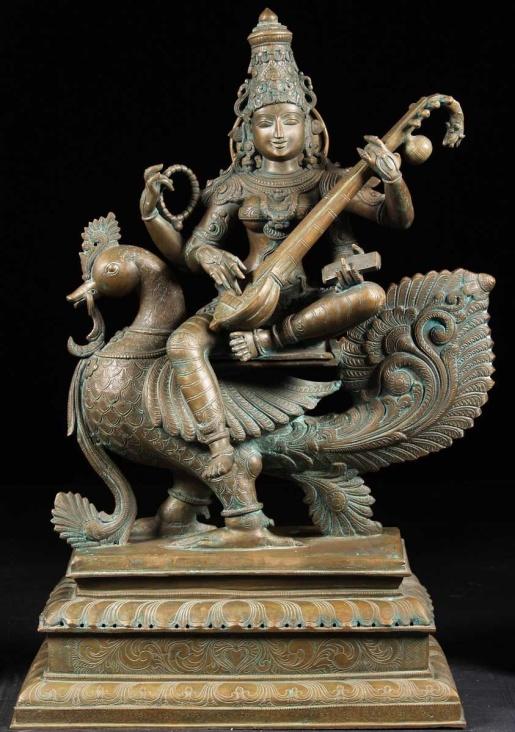
The kriti SharAvati taTavAsini is set in the 25th ragAnga raga sharAvati. In this kriti he visualises Her as one who resides on the banks of the river sharAvati, one who has a swan as Her vehicle (hamsini), one who personifies word and meaning (shabdArtha svarUpiNi) and one who delights in the music of the flute and the vINA (muraLi vINA gAna vinodini). This short kriti ends with a catchy chitta svara. Dikshitar employs a distinctively different usage of the vivAdi notes in this rAga.

BhArati maddiShaNA jADyapahe is an enthralling composition in the raga Devamanohari. The essence of the famous shloka “yAkundendu tuShAra hAra dhavala “is incorporated in this kriti. He refers to Her as the ever compassionate one who removes the inertness of our mind and is like a wish-fulfilling tree for Her devotees.
The melodic structure of this kriti gambolling from the mandara stayi panchama to the Tara stayi madhyama is truly magical. The musical arrangement of the word jaDyApahe – M r s r m – that lands charmingly on the madhyama is a rare find in the musical wealth of Dikshitar. The phrase ‘p n n s’ in the ascent is yet another characteristic feature in the Dikshitar school instead of ‘p d n s’ that we hear commonly.
The renditions of vINApustakadhAriNim in vegavAhini have been immortalised by the redoubtable Vina Dhanammal, all the renowned musicians in her family and their shishya paramparas.
In this evergreen composition, Dikshitar describes Sarasvati as one who bears the vINA and pustaka in her hands. The vINA apart from being a musical instrument is also an aid to spiritual progress. The YAjnavalkya smrti declares
“vINAvAdana tatvajnayah shrutijAtI vishAradaH.
tAlajnashchAprayAsena mokshamArgam niyacchati “
“One who is well versed in the secrets of the art of playing the vINA attains liberation without much effort”

The spinal cord in the human body is also referred to as the vINA daNDa. The Goddess resides in the bottom of the spinal column as kunDalini. Through intense yoga sAdhanas, she arises and ascends swiftly along the column sushumna (the raga name vegavAhini also suggests swift movement) flanked by the channels iDa and pingaLa, flows through the six energy centers and unites with Shiva in the thousand petalled sahasrAra at the topmost part of the brain, thus enabling the sAdhaka to attain liberation. All the nerve endings in our body are connected to this column. As a result of that, the Goddess bestows the power of discretion and cognition, and governs the intellect in its various manifestations.
Dikshitar also visualizes her as the embodiment of the four-fold form of shabda – parA, pashyantI, madhyamA and vaikhari. Dikshitar also notes that Sarasvati resides on the tip of the tongue of the learned and the pious-nirantaram bhakta jihvAgravAsAm.
The very sight of people with negative thoughts and energies can cause immense anguish in one’s psyche. Dikshitar mentions, in this composition, Sarasvati removes the pain caused by even a glance of ill-minded individuals – narAdhamAnana viloka shOkApahAm.
VegavAhini is the 16th rAgAnga raga. Dikshitar has painted a succinct picture of the raga replete with subtle nuances in this kriti. An important phrase of this raga S m g m is indicated in the very first line of the composition.
In the kriti kalAvati kamalAsana yuvati, Dikshitar addresses her as Sharada, the presiding deity of Kashmira, considered the Sarvagnya Pitha. Kashmira was known to be the seat of all learning in ancient India and hence the abode of SarasvatI. The influence of Shri Adi Shankara’s works on Muttusvami Dikshitar can be seen in the usage of the sahitya. sharajjyotsnA shubhrAkAra in the charanam is reflective of the Shloka sharajjyotsnA shuddhAm from Shankara’s Saundaryalahari.
The haunting melody for this line is also a highlight in this kriti. SarasvatI is depicted as the embodiment of all mantras and the matrka (51 aksharas from a to ksha) in this kriti.
In the anupallavi of the kriti, a probable reference is made to the bala-atibala mantra, into which Sage Vishvamitra initiated the young Rama and Lakshmana. This mantra includes the renowned Gayatri mantra (also known as the Savitri mantra, of which also, Vishvamitra was the seer). During Sandhyopasana, the Goddess Sandhya is meditated upon as the forms of Gayatri in the morning, Savitri in the afternoon and Sarasvati in the evening.
Kalavati is the 31st raganga raga in the tradition that Dikshitar followed. Though it bears the same name, the raga is not the same as seen in the Tyagaraja Parampara or the Hindustani tradition. Also, this raga is starkly different from Yagapriya, its counterpart in the Melakarta scheme.

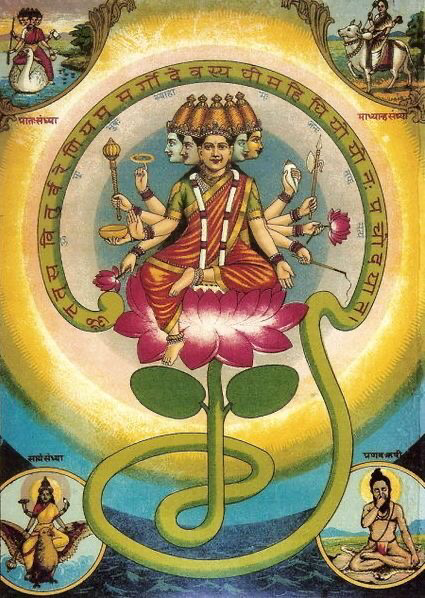
NamO namaste gIrvANI is set in the 43rd Raganga raga GIrvANI.
Dikshitar describes her as the embodiment of the Vedas. The vAk bija ‘aim’, also known as the Sarasvata bija, is a composite of the first syllables of the Rig, Yajur and Sama Vedas and the bindu. She is the three-fold form of nAda, bindu and kalA(nAda bindu kalA shreNi) . Expounding in simple terms, nAda is the source of all sound, bindu is the source of all forms and kalA is the expression of these.
GIrvANI has been sometimes mistaken to be the raga kIravANI and there are renditions of this kriti in kIravANi. GIrvANI is the 43rd Raganga raga and has no connection with kIravANI which is the 21st Melakarta. This is a short kriti with an intricately woven chitta svara passage.

Siddhalinga Svami was the spiritual Guru of the erstwhile
Maharaja of Mysuru Shri Jayachamarajendra Wodeyar)
ChAyAgaula is a upanga janya of the 15th raganga raga mAlavagaula.
The well-known shloka
“sangItamapi sAhityam sarasvatyAH stanadvayam
ekam ApAna madhuram anyadAlOcanAmRrtam “
(Sarasvati nurtures us with the milk of music and literature which are her two breasts) is condensed in the description of Sarasvati in this kriti.
A mention is made again of her presence in the intellect and the tip of one’s tongue (matimajjihvAgrasthitayA). Dikshitar envisages her radiance in dazzling white shades (chAyagauratarayA) and pictures her as draped in swirls of white fabric (shubhra vastrAvrtayA). He also perceives her as a personification of the 64 art forms (chatusshashtikalAtmikayA).
The structure of the kriti SarasvatI chAyAtaraNgiNi bears resemblance to that of a flowing river. In this kriti she is portrayed as the lotus-faced divine force who destroys all sins (sakala durita bhanjani) and as the epitome of Sat – chit – Ananda sought by the learned (budhajanopAshrita satchit sukhi). A brisk madhyama kala passage and a sprightly chitta svaram add sheen to the composition. A marked contrast can be seen in the handling of chAyAtarangiNi in the Dikshitar and Tyagaraja paramparas.
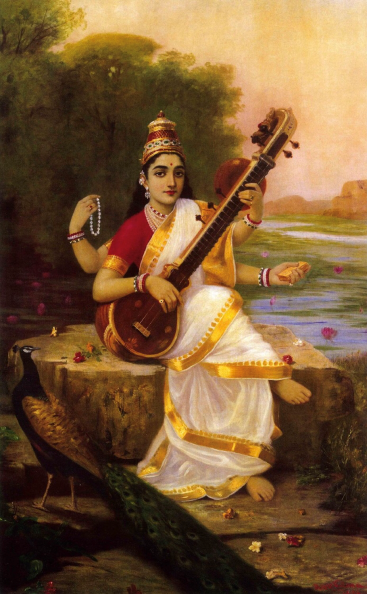
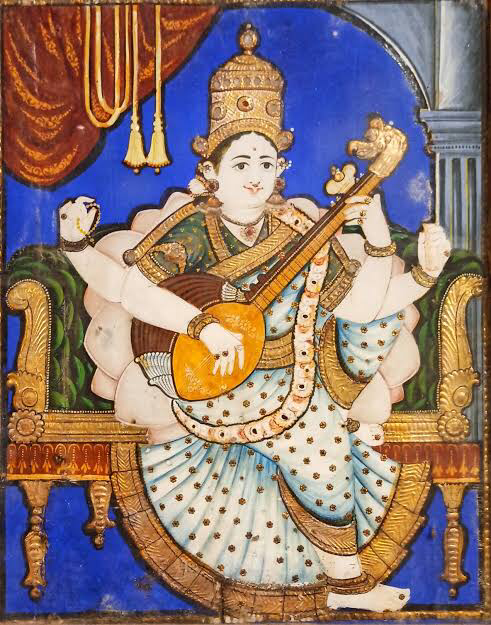
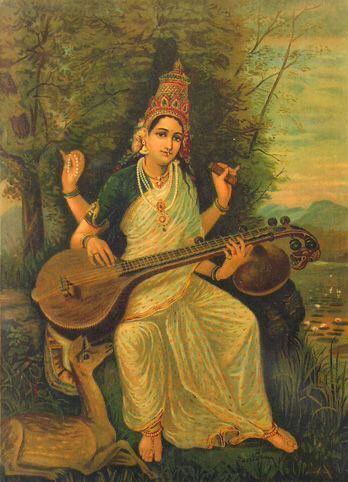
ShrI Sarasvati namOstute is a popular and often sung composition on the Goddess. The raga name has been woven seamlessly into the kriti in the phrase, samsAra bhItyApahe (one who removes the fear of samsara), a quintessential example of Dikshitar’s genius. To attain the knowledge and experience of the Supreme Being, one has to shed the three vAsanAs – lOka vAsana (desire of worldly pursuits), deha vAsana (attachment to the physical body) and shAstra vAsana (obsession with scriptural injunctions). Sages who have transcended the three vAsanAs, contemplate on her form as the Supreme Being – vAsanAtraya vivarjita varamuni bhAvita mUrtE. This kriti also has a chitta svaram that is not rendered often.
Dikshitar has also dedicated vAgdevi mAmava, one of the nottusvarams to Goddess SarasvatI. He portrays the form of Sarasvati in the four lines of lilting English music.
This article is a bird’s eye view into the enormous and invaluable contribution of Muttusvami Dikshitar to the dazzling repertoire of kritIs on Sarasvati.
May Goddess Sarasvati guide us into the realm of this musical bliss and eternal joy.
Amritha Murali

